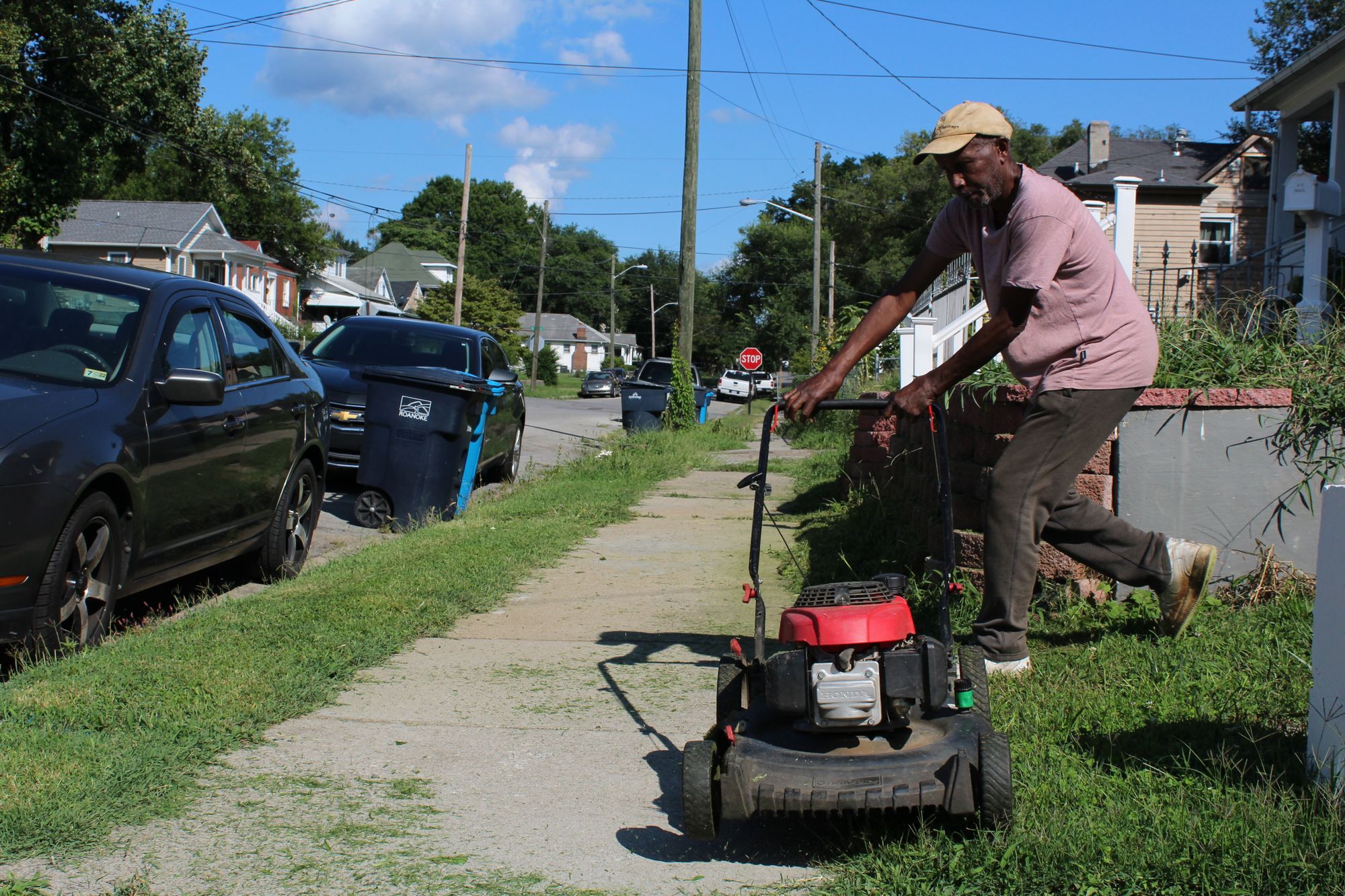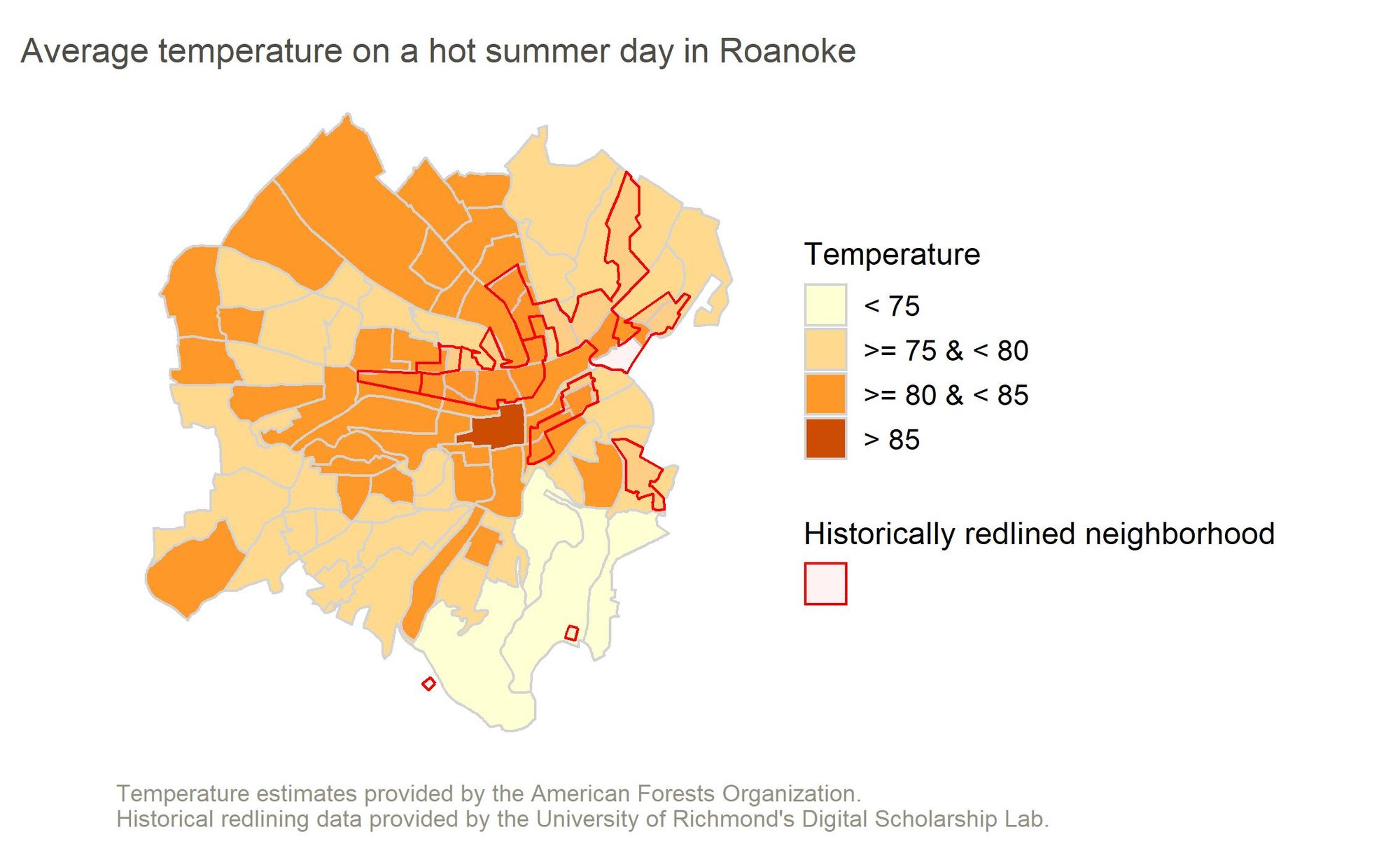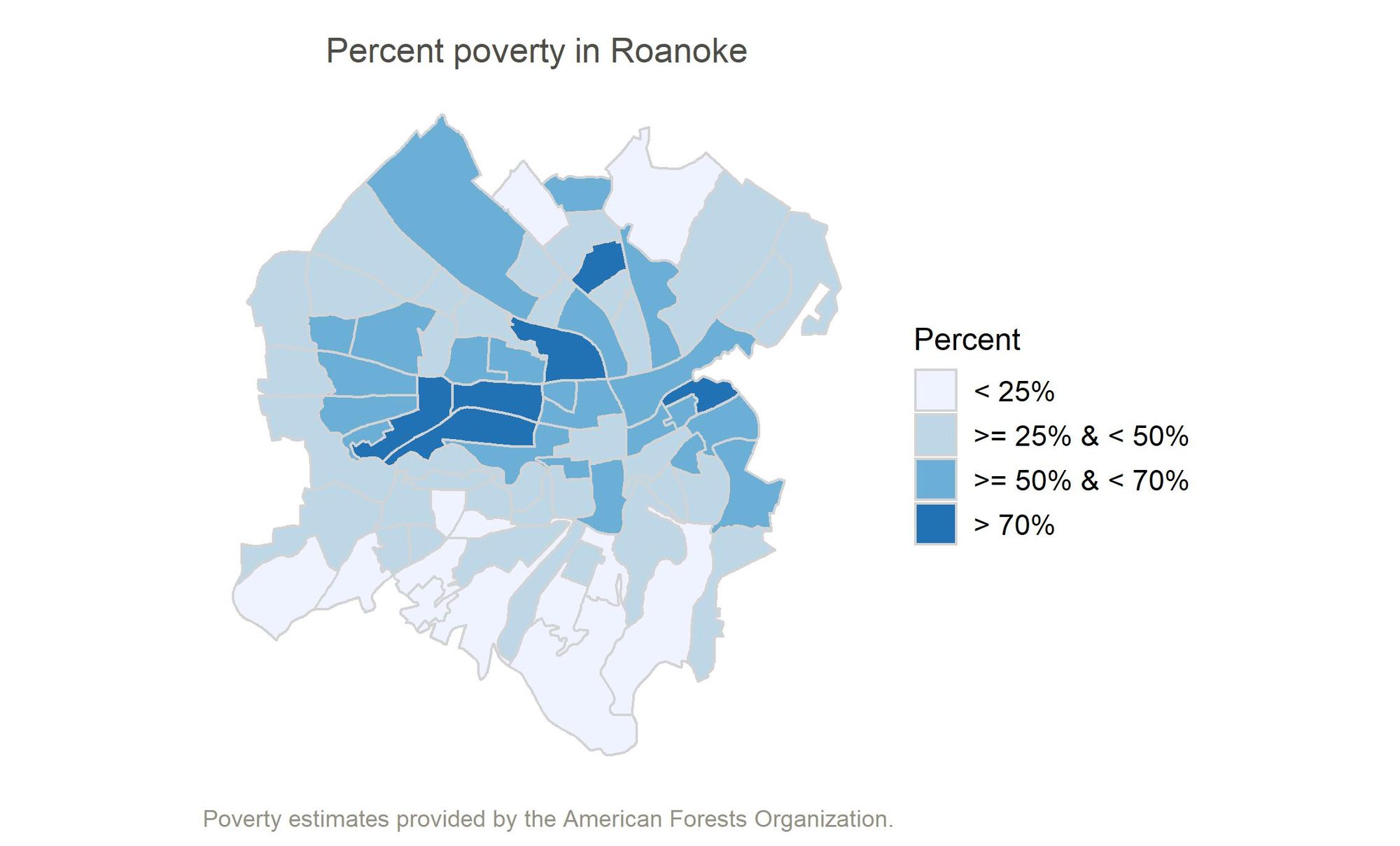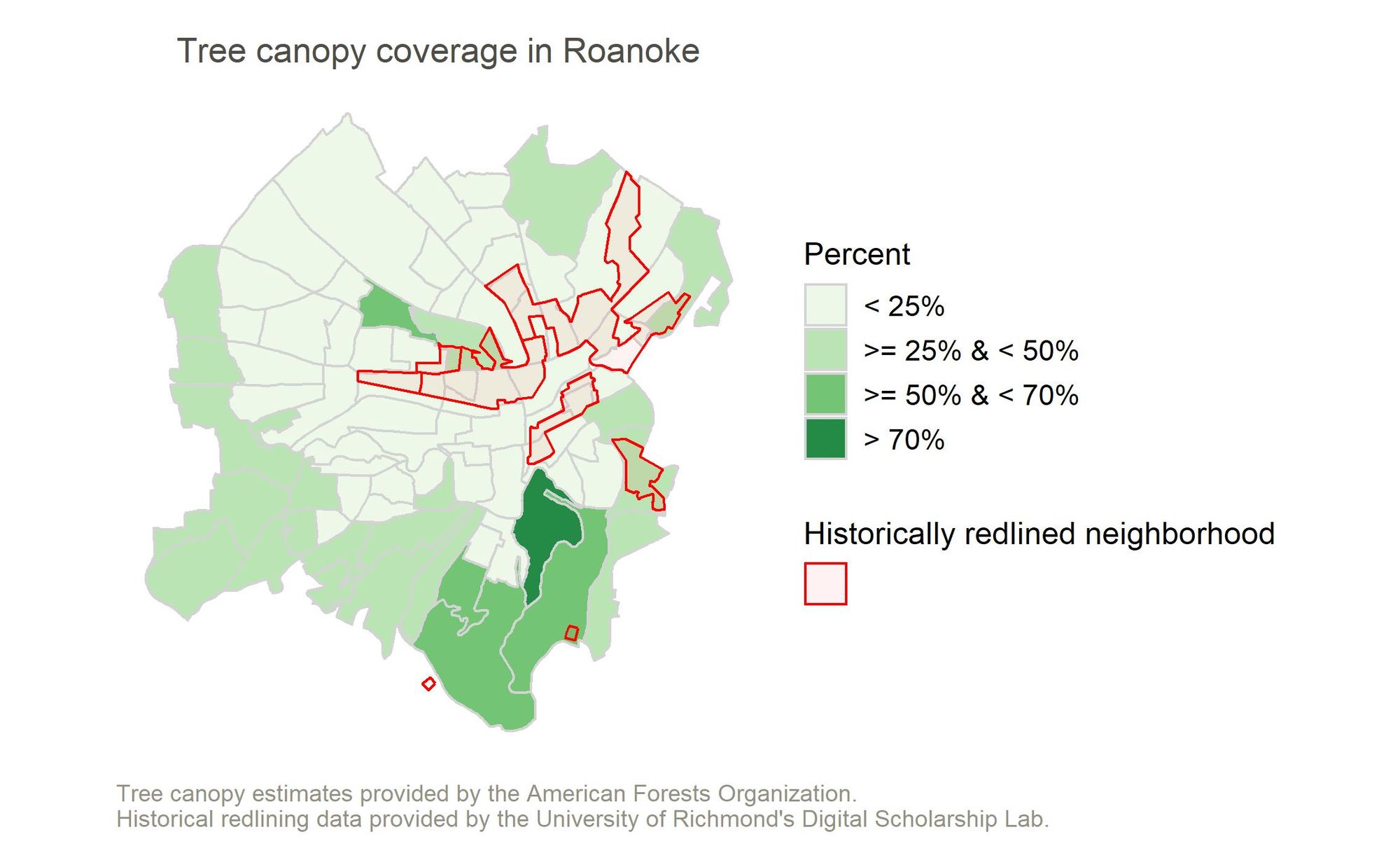As Roanoke Grows Hotter, Poor and Black Neighborhoods Face the Most Danger, Study Shows
Extreme heat can pose a huge threat to the safety and prosperity of a neighborhood, a community and an entire city.

As he mows his neighbor’s lawn, Charles Robinson is thinking about the end of days.
Sweat glistens on Robinson’s head as he squints in the harsh sunlight. Robinson, 66, cites climate change and the COVID-19 pandemic as he talks about the way the world is deteriorating around him.
“Everything’s right on schedule, Biblically speaking,” Robinson said.
Robinson lives on Rutherford Avenue Northwest in the Gainsboro neighborhood and helps his neighbors with their lawns. On this hot, sunny Saturday in mid-August, he’s finishing up his third lawn of the day.
This is one of the hottest neighborhoods in Roanoke, according to a recent study done by city employees and community members.
Extreme heat — and even moderate heat over a prolonged period of time — can pose a huge threat to the safety and prosperity of a neighborhood, a community and an entire city. There are some simple solutions cities can implement, including increased funding for landscaping and caring for trees in urban areas. But as with any environmental challenge, it will likely take numerous adjustments in funding and prioritizing to make a lasting difference, experts and city officials say.
The effects of heat on communities is well documented, though perhaps not widely known. Heat is more deadly than any weather-related hazard. Michael Allen, an associate professor of geography at Old Dominion University, said most people don’t realize that.
“It's the most deadly weather-related disaster,” Allen said. “More than hurricanes, more than flooding, more than tornadoes, oftentimes more than any of those combined.”
What is not as well documented is which areas of cities are most vulnerable to extreme heat. Some areas of cities, due to a number of factors, feel the effects of heat more intensely than other areas. This is often referred to as the Urban Heat Island (UHI) effect. On heat maps, these so-called islands stand out in bright red as much hotter than other areas.
At least a dozen cities in Virginia have been professionally heat-mapped like this, which Jeremy Hoffman, a scientist at the Science Museum of Virginia, said is the most of any state in the country. These studies help identify vulnerable populations.
But it’s up to city officials to find solutions.
What the study says
The heat map study, conducted on Aug. 20, 2020, was funded by a grant from the National Oceanic and Atmospheric Administration (NOAA). Volunteers and city staff measured temperatures all over town at various points in the day and compiled them all together to identify which areas were the hottest.
Nell Boyle, the sustainability and outreach coordinator for the City of Roanoke, said the findings weren’t surprising. The hottest areas of town were the Belmont, Avondale and Gainsboro neighborhoods.

These areas have a few factors in common. The most obvious, which is evident while walking or driving through the neighborhoods, is that there’s relatively little tree cover.
Take Robinson’s street in the Gainsboro neighborhood. Though there are a decent amount of trees visible nearby, there’s only one large oak tree on this block. On a hot day, it only takes a few moments to break a sweat walking down these sidewalks, and there’s no shade to break up the walk.
A history of racially discriminatory policies has played a factor in the development of heat islands as well, studies have shown. In the wake of the Housing Act of 1949, a wave of strategic rebuilding swept through hundreds of American cities. This process, commonly known as urban renewal, displaced entire neighborhoods to build industrial areas. In many cities, including Roanoke, these neighborhoods were predominantly Black.
In Roanoke, urban renewal began in northeast Roanoke and swept through downtown to Gainsboro. Urban renewal destroyed 1,600 predominantly Black homes, 200 Black-owned businesses and dozens of churches.
Roanoke City Councilman Joe Cobb pointed out that large swaths of trees and other vegetation were also eliminated during urban renewal, eliminating natural shade and reducing air quality in the neighborhoods.
“You can just look in before and after pictures, dating back to the late ’50s, early ’60s and see that,” Cobb said. “It's not like you have to dig very deep to prove and reveal the differences.”
A 2020 study by the Science Museum of Virginia found a correlation between heat island effect and redlining — a New Deal-era housing and development practice that targeted Black and working-class neighborhoods as “hazardous” or less desirable for investment. As a result, these neighborhoods struggled while others around them flourished.

Comparing a historical map of areas in Roanoke that were deemed “hazardous” or undesirable to the recent heat map will show a great deal of similarities. In large part, areas that were denied investment in the 1930s and 1940s are more asphalt and less green than so-called “desirable” neighborhoods, resulting in greater heat danger.
Clear-cutting urban areas creates a long-term problem, as Cobb points out, because old-growth trees can usually provide the most shade and the most stable root systems. Planting new trees is a good step, but young trees can only do so much.
What can a city do?
The causes of heat islands in cities are deeply ingrained and come to light over long periods of time. Cities across the country are finding that solving heat-related problems is also an intensive, lengthy process that takes years to yield meaningful results.
City officials in Knoxville, Tennessee overhauled the city’s code in 2019, and made heat islands a priority. They beefed up the landscaping section of the code, putting more funding and effort into landscape maintenance, planting trees (especially in parking lots), prohibiting the planting of invasive species, and more. They also added a staff member to inspect the work and review landscaping plans with great detail.
The city code explicitly states that these changes are meant to combat heat islands. Kasey Krouse, the urban forester for the City of Knoxville, said the impacts of these changes “will not be known for years, but we know more green is better, and the code does emphasize more green.”
There’s more to heat islands than landscaping, though.
Allen likened the battle against heat islands to a game of Jenga, where there are numerous pieces to the whole, and everything is connected.
It’s important for city leaders to keep in mind that cities should be designed for people instead of machines, Allen said. Making urban areas more densely populated and walkable are good ideas, he said. Reducing the amount of greenhouse gases will, in the long run, reduce the number of extreme heat events, Allen said, so putting an emphasis on electric vehicles is also a smart plan.
Trying to reduce the severity of urban heat islands also connects with other missions of a city, as Cobb pointed out. As city council members consider ways to reduce poverty in the city, they understand that heat is a factor in that. If one neighborhood is dramatically hotter than another, for instance, the residents are more at-risk for heat-related injuries, which can result in medical expenses, missing work or missing school.

Residents of the hotter neighborhoods also have to spend more money to keep their homes cool, like Jeff Carter in the Belmont neighborhood. The August sun is blinding as it bounces off this white house that Carter has called home for the past 61 years. Carter has put ceiling fans in every room of his house, he said, in addition to at least one window air conditioning unit in an effort to combat the heat.
What Roanoke is doing
For the first time in more than a decade, Cobb said, the city council increased the urban forestry program’s funding in last year’s budget. Bill West, urban forestry coordinator for the City of Roanoke’s Parks and Recreation Department, said the city doubled its commitment to urban forestry in the budget, bumping it from $30,000 to $60,000 in last year’s budget.
He said this increase was driven by many groups — city council members, the Parks and Recreation Advisory Committee, the Parks and Recreation division manager and director, and numerous members of the community who made it clear they wanted this to be made a priority. West specifically mentioned the Tree Stewards, a volunteer group in Roanoke that plants and maintains trees, advocates for more tree planting, and educates people about the importance of trees.
Boyle said a good deal of this increased funding goes not to planting new trees, but keeping older, larger trees healthy.
“The real issue with the city is trying to maintain some of those older trees, which is sort of an expensive process and labor-intensive,” Boyle said. “So we are aware, yes, planting trees are part of that scope of work that would be helpful, and also sort of trying to maintain those trees that we have.”
The increase in funding is a welcome change, as the amount of area covered by trees has plummeted in Roanoke since 2008, when the city cut funding to tree planting. Tree canopy coverage went from almost 48% in 2008 to just 26% in 2019, according to the city’s 2040 Comprehensive Plan.

The council also heard a report from Sean McGinnis, director of the Green Engineering Program at Virginia Tech, and Boyle in part about the heat map study at its regular Aug. 16 meeting. At that night’s public hearing, four members of the public spoke in support of the city taking this study seriously and making a firm commitment to combating heat islands.
Cobb said he and his fellow council members took the report and the testimony seriously. The process for the next fiscal year’s budget begins this month with the city council’s annual retreat. Cobb said the heat map study will certainly be a topic of discussion at that retreat, and that it will be taken into account as the city puts together its budget.
“One thing that's clear to all of us is that we support increased tree cover,” Cobb said. “So what goes alongside that is the budget component, and what we can reasonably do. I think the other thing that we heard loud and clear was that we are in a climate emergency. And we need to take action.”
Educating and engaging
As Krouse and others in Knoxville found, there’s one key way to start making progress in changing policies to combat heat islands: education.
“The biggest challenge is aligning the community on a common understanding of the impact of heat islands and what is needed to combat its effects,” Krouse said.
Boyle said her office is already working on ways to educate and engage the community. Along with researching more into the connections between the heat islands and vulnerable populations, the city is planning a partnership with Virginia Tech to start programs in local communities to educate young people about the importance of heat and how to combat it.
Beyond young people, there is also a need for community involvement on a broader scale. Walking around Roanoke’s hottest neighborhoods, you’ll see many similar sights — sunscreen and water bottles lining porches, mail carriers sitting in their air conditioned cars for a few moments, people gathering in shaded alleys for afternoon breaks.
But you’ll also hear a similar attitude toward the heat: It is what it is. Robinson, the Gainsboro resident mowing lawns, shrugged his shoulders when asked if he thought more trees would make the neighborhood a little cooler.
“We’ve got enough trees around here,” Robinson said. “We’ve got to just deal with it.”
The attitude of “dealing with” the heat goes back to what Allen said about people underestimating the dangers of heat. Studies from coast to coast have shown that higher heat results in increased health problems and injuries. Record-setting heat waves are claiming lives all over the world.
As Knoxville city officials are experiencing, improvement on this front takes time. But changes and investments made now — even relatively small ones, like bumping up the urban forestry budget or setting up partnerships to educate residents — can help prevent long-term damage and even save lives down the road.
Correction (9/8/21) — The full name of the National Oceanic and Atmospheric Administration (NOAA) was inaccurate and has been corrected.

